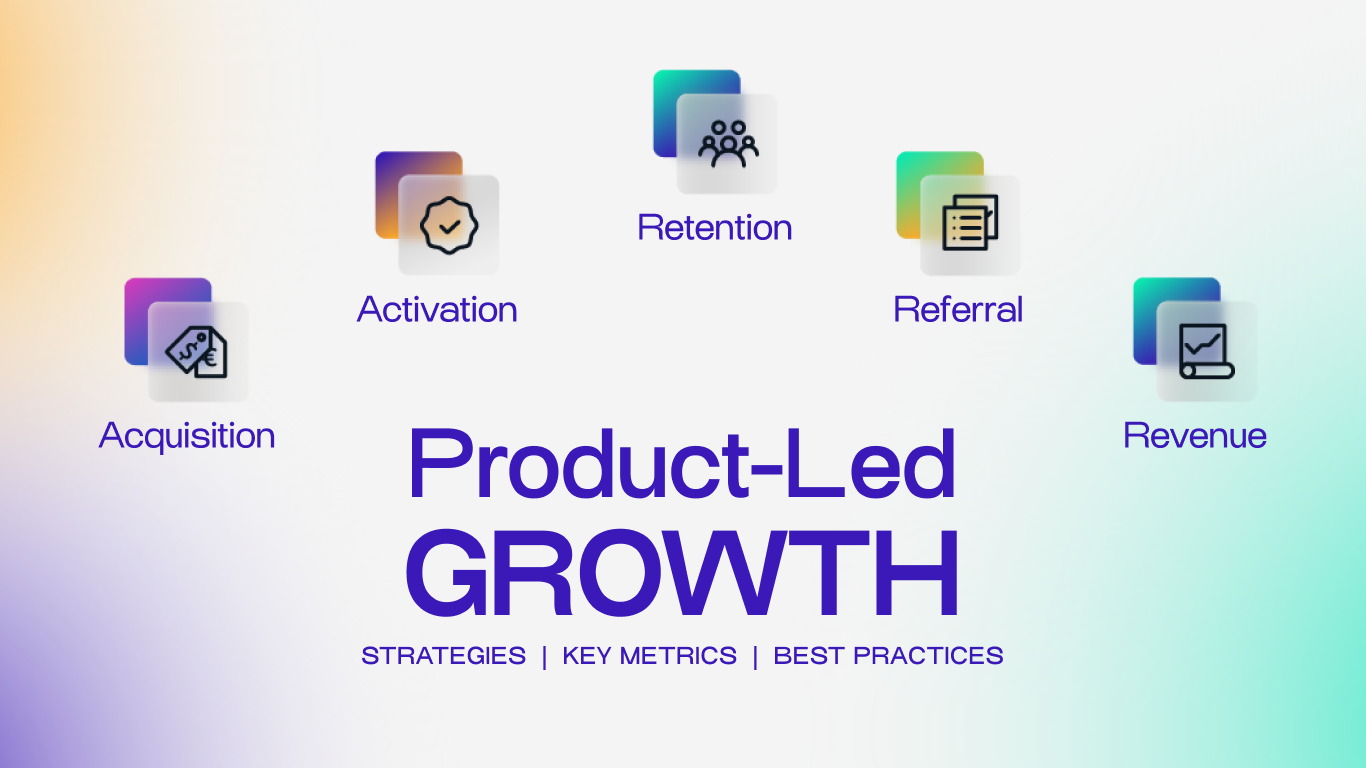In the ever-more competitive world of SaaS, we've seen a new growth strategy emerge over the past few years. One that is leaving traditional sales and marketing-led strategies behind.
It's a revolution not led by flashy sales decks or dazzling ad campaigns but by the silent charm of product value. The winning growth strategy is about creating phenomenal products that sell themselves.
Metrics play a key role in any growth strategy, to measure results and optimize the winners, but product-led growth (PLG) companies have to focus on a different set of metrics than their more-traditional counterparts.
How Growth Strategies Impact Key Metrics
There are three main categories of growth strategies: sales-led, marketing-led, and product-led. Each has its own set of relevant metrics and understanding what differentiates them is key in making them effective.
Sales-led businesses rely on their sales team to drive customer acquisition and will look at sales cycle lengths, lead conversion rates, and deal sizes.
Marketing-led companies emphasize creating demand through advertising, promotions, and public relations. These companies focus on customer acquisition costs (CAC), customer lifetime value (CLV), and conversion rates.
Product-led growth companies, in contrast, focus inward on creating superior products that fulfill customer needs so well that the product itself becomes the primary driver of acquisition, conversion, and expansion.
PLG companies look at in-product metrics like adoption, retention rate, churn rate, Monthly/Annual Recurring Revenue (MRR/ARR), Daily/Monthly Active Users (DAU/MAU), and Product-Qualified Leads (PQLs).
Key Metrics for Product-Led Growth
The AARRR (Acquisition, Activation, Retention, Referral, Revenue) framework provides a useful model for understanding customer behavior in a PLG company.
Acquisition
Acquisition refers to how users find and start using the product.
Product-Qualified Leads (PQLs): These are potential customers who have shown interest in the product through usage, indicating a higher likelihood of conversion.
Customer Acquisition Cost (CAC): This metric indicates the average expense of acquiring a new customer. Lower CAC implies an efficient acquisition strategy.
Daily/Monthly Active Users (DAU/MAU): These metrics indicate the number of unique users who engage with the product on a daily or monthly basis.
Activation
Activation is about users having a positive first experience using the product.
Time to Value (TTV): This is the time it takes for a new user to achieve value from the product. Shorter TTV means a more effective product at delivering initial value.
Product Adoption Metrics: These provide insights into how many users are actively using the product, how frequently, and for what purposes.
User Onboarding Success Rate: This measures the percentage of users who complete key onboarding steps. A high rate suggests effective user activation.
Retention
This considers how many users continue using the product over time.
Retention Rate: The percentage of customers that continue to use the product over a given period. High retention indicates high customer satisfaction.
Churn Rate: The percentage of customers who stop using the product over a given period. Lower churn rates are desirable as that signals users find ongoing value in the product.
Customer Lifetime Value (CLV): A high CLV typically indicates successful retention strategies, as customers find consistent value in the product.
Referral
This focuses on how users are championing the product to others and the inherent shareability of the product.
Net Promoter Score (NPS): A staple metric in gauging customer satisfaction. NPS measures how likely customers are to recommend your product to others. High NPS scores indicate strong customer loyalty and satisfaction.
Referral Rate: This reflects the percentage of your users who bring in new customers. A higher referral rate will increase user acquisition and is a great indication that your users aren’t just satisfied - they are enthusiastic.
Viral Coefficient: At its core, the viral coefficient measures how many new users an existing user brings into your product. A coefficient higher than 1 shows that the product has organic growth potential with each new user bringing in more than one additional user. Remember during Covid when we were focused on bringing the R-value below 0 to stop the viral spread and exponential growth of new cases? This metric works just like that, but in this case, virality is a great thing for your product!
- Viral Loops: These power your viral coefficient. The loop starts when a user shares the product, which leads to new users signing up, who then continue the loop by sharing again.
- Word-of-Mouth: When users genuinely love a product, they naturally talk about it. This can happen online and offline and often brings in users who are more likely to stick around as they trust a personal recommendation over traditional advertising.
Revenue
Last but not least in importance, how much money a company makes from its users.
Monthly/Annual Recurring Revenue (MRR/ARR): For subscription businesses, this measures predictable monthly or annual revenue.
Average Revenue Per User (ARPU): This metric calculates the revenue generated per user and is critical in understanding monetization effectiveness.
Net Dollar Retention (NDR): This measures the percent change in retained revenue from existing customers over a given period. A high NDR rate signifies that your existing customers are spending more over time, which indicates strong product value and customer satisfaction. It's particularly important for SaaS businesses or any subscription-based model where growth is significantly impacted by upsells and cross-sells.
As a company grows and evolves, the metrics they care about will change - that’s okay!
Early on, when a company is still trying to nail that product-market fit, it’s all about acquiring users, seeing if those users are happy to refer the product to others, and if they are happy to pay for it. A more established company will shift its focus to prioritize growing revenue and reducing churn so they are more easily able to raise a new round of funding based on revenue growth.
Let's look at some examples
Slack
Slack, the ubiquitous workplace communication tool, exemplifies a successful product-led growth strategy.
Acquisition & Activation: Slack gained rapid traction by providing a frictionless onboarding process that allowed users to experience immediate value. Their product was designed to be inviting, intuitive, and easy to navigate, thus reducing the Time to Value (TTV). High DAU/MAU ratios were a clear indicator of the product's stickiness and regular usage.
Retention: Slack focused on user retention by constantly updating and improving the platform based on customer feedback, keeping the retention rates high.
Referral: Slack's NPS has historically been high, pointing to high customer satisfaction and a willingness to recommend the product to others, resulting in organic growth through word-of-mouth.
Revenue: Slack utilized a freemium model, wherein basic services were free, but additional premium features came at a cost. With strong user adoption and high retention rates, Slack was successful in converting a significant portion of free users to paid ones, thereby boosting their MRR/ARR. As their customers' teams grew, the Net Dollar Retention (NDR) also increased.
Figma
Figma, a cloud-based design tool, leveraged PLG to revolutionize the design industry.
Acquisition & Activation: Figma, like Slack, employed a freemium model. This allowed users to try the product and derive value from it before making a financial commitment. Their product adoption metrics showed high engagement levels, with users spending a significant amount of time on the platform.
Retention: Figma focused on community-building and collaborative features to retain users. The product allowed multiple users to work on a design simultaneously, providing a unique value proposition that kept users coming back.
Referral: Due to the collaborative nature and ease of use, Figma users were often bringing in more and more of their peers which helped with acquiring more users and expanding the existing customer base.
Revenue: Figma’s revenue was driven by converting individual users and small teams on the free plan to their paid plans, as well as landing larger enterprise deals with businesses whose teams were already using and loving Figma. This strategy, combined with a high Net Dollar Retention rate, contributed to Figma's significant revenue growth.
Both Slack and Figma successfully utilized the key metrics associated with a product-led growth strategy to drive their impressive growth trajectories.
Best Practices for Using Metrics in PLG
Continuously Monitor, Optimize, and Leverage Tools: Use analytics tools and dashboards to monitor metrics regularly, spot trends, and visualize data. Based on these insights, take necessary actions to optimize performance. If certain metrics are not meeting set benchmarks, investigate the issue and implement corrective measures.
Set Clear Goals: Each metric should have a clear goal or benchmark. This helps in assessing performance and directing efforts effectively. For example, if the aim is to increase Monthly Active Users (MAU), a target growth percentage can be set for each quarter.
Understand the Interplay Between Metrics: Each metric does not exist in isolation. They interact with each other and changes in one can impact others. For instance, efforts to increase monetization might lead to an increase in churn rate. Understanding these interactions can help in developing a balanced and effective growth strategy.
Use Metrics to Inform Product Development: Metrics like product adoption rate, daily active users (DAU), and net promoter score (NPS) can provide valuable insights into how the product is being used and perceived. Use these insights to guide product development decisions.
Prioritize the Right Metrics at the Right Time: Not all metrics carry equal importance at all stages of a company's growth. Early-stage startups might focus more on acquisition and activation metrics, while mature companies might give precedence to revenue and retention metrics. Choose the right metrics to focus on based on your company's current growth stage and business goals.
Conclusion
Growth magic happens when you start focusing on improving the right metrics. Looking at Slack and Figma, it's clear that a PLG strategy executed correctly can skyrocket a company's success. Both have used these metrics to grow like crazy, improving their products and boosting their bottom line.
Keep a close eye on your metrics, know what you're aiming for, and remember that your product should always be improving. And above all, remember that it's all about the users. Make a product that they love, and growth will follow.




